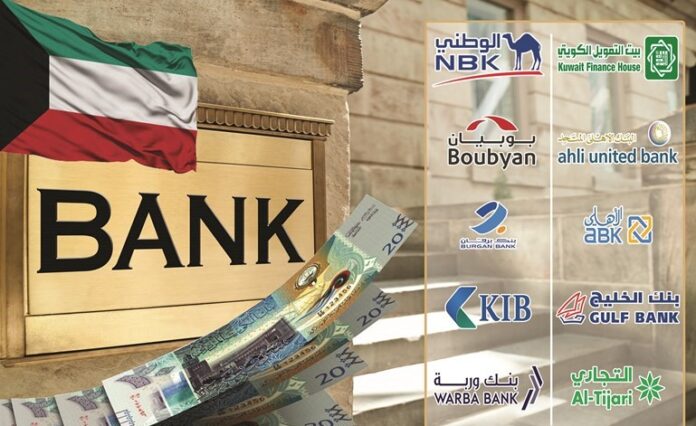Standard & Poor’s (S&P), the global credit ratings agency, has released a report forecasting that Kuwaiti banks will maintain robust profitability throughout the current year. This outlook is underpinned by the banking sector’s favorable positioning to capitalize on the prevailing high-interest rate environment over the long term.
Highlighting certain dynamics, the report added that the rise in net interest income will be offset to some extent by the move from non-interest deposits to interest-bearing deposits and the increase in credit losses. However, financing in the banking sector continues to benefit from a strong domestic deposit base and a net external asset position, and this translates into positive investor sentiment, reports Al-Anba daily.
In terms of lending growth, the agency expects it to remain weak, as banks’ lending records expanded at an annual rate of 3% in the first half of 2023, which is much lower than loan growth of 8% in 2022.
S&P expects that higher interest rates will lead to lower demand from corporate and individual borrowers, which will translate into low single-digit growth in banking sector loans.
Overall, the agency expects the cost of risk to rise and normalize by about 60-70 basis points in 2023 and 2024, from 40 basis points in the first half of 2023 and at the end of 2022. However, high provision margins, which could offset the potential increase In non-performing loans, it will enable banks to maintain broad stability of the non-performing loan ratio.
Regarding the situation of the region’s banks, the agency said that rising interest rates will reduce credit growth at Gulf banks, but the performance of Saudi and Emirati banks will be more flexible. We expect that the rise in interest rates will lead to a decline in credit growth at Kuwaiti banks to about 3% from about 8% in 2022, and a decline in the total lending growth of Saudi banks to about 10% in 2023, from 14% in 2022.
On the other hand, UAE banks will benefit from continued strong non-oil GDP growth, which will somewhat mitigate the negative impact of higher interest rates on credit growth. We expect credit growth at UAE banks to improve to about 7% in 2023, compared to 5% in 2022.
But prolonged high interest rates and a slowdown in the oil economy may pose challenges. Qatari banks, unlike their counterparts in the Gulf countries, will continue to face a sharp decline in credit growth, because the country’s major infrastructure projects, which are the main driver of credit demand through contractors, have been completed before hosting the 2022 FIFA World Cup.
S&P expected a slight decline in asset quality measures, but we believe that the negative impact on bank returns will be limited. High interest rates led to a sharp rise in borrowing costs. We believe that the resulting slowdown in demand in the real estate rental market will weaken the asset quality metrics of Qatari and Kuwaiti banks.
In addition, the decline in Qatari banks’ exposure to foreign lending will contribute to the costs of loan losses. However, Qatari banks’ strong exposure to the public sector and high Kuwaiti banks’ provisioning spreads will mitigate the negative effects and limit the increase in non-performing loan ratios.
The agency also notes that the UAE will record strong non-oil GDP growth of 6% in 2023. This, along with recoveries of allocations reserved in the past two years, will lead to lower credit costs at UAE banks in 2023 compared to 2022.
Although credit costs in the Gulf region will rise, with the exception of the United Arab Emirates, we still expect the return on assets of Gulf banks to improve in 2023, resulting mainly from higher margins and lending growth that is still acceptable, albeit at a slower pace. In some Gulf countries.
S&P pointed out that the Kingdom of Saudi Arabia’s Vision 2030 program has provided an incentive for growth for Saudi banks, which will continue to contribute to increasing the return on assets, compared to their Gulf counterparts. We expect Saudi banks to achieve a return on assets of 2.2% in 2023, compared to the average of their Gulf counterparts of 1.8%.
While higher interest rates will reduce Saudi banks’ overall lending growth, projects linked to the Kingdom’s Vision 2030 will keep credit growth well above the average of their Gulf counterparts of 4% in 2023.
Increased lending to businesses, higher interest rates, and portfolio volatility are likely to lead to an uptick in non-performing loans and credit costs. However, Saudi banks’ asset quality metrics will remain better than the average of their peers, given their significant exposure to government-backed mortgage lending. We expect the non-performing loan ratio to reach 2.1% and credit costs to reach 60 basis points for Saudi banks in 2023, compared to 3.5% and 90 basis points, respectively, for their Gulf counterparts.
Liquidity conditions will become tighter. For Saudi banks, we expect that tightening liquidity conditions will reduce the benefit from higher asset returns, because banks will be forced to pursue more expensive financing options, while deposits will continue to move to interest-earning instruments.
It is also worth noting Qatar, where banks are gradually reducing their recourse to external financing and replacing part of it with more volatile sources, for example, by replacing non-resident customer deposits with interbank deposits of non-residents. Buyers in Kuwait and Qatar will face liquidity pressures in the form of higher financing costs, which could exacerbate risks to real estate demand and prices.
Capitalization remains a source of strength for Gulf banks. GCC banks have always enjoyed comfortable capital margins, and we do not expect that to change. We believe that slowing credit growth and rising profits mean that GCC banks’ capital metrics will remain stable. Banking systems in Saudi Arabia, the United Arab Emirates, Qatar and Kuwait recorded a regulatory Tier 1 capital ratio of 15% or more in 2022.

















